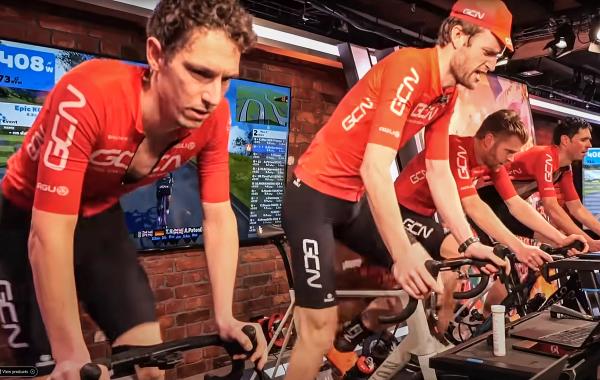Should we all be doing ramp FTP tests?
Is the universal 20-minute power test really the best and most accurate way of calculating your functional threshold power?
Alex Hunt
Junior Tech Writer
© GCN
It is unavoidable, finding out your FTP is not going to be comfortable
If you have ever trained with a power meter you will have almost immediately been met with the need to input a metric known as your functional threshold power (FTP).
Knowing your FTP will allow training programs to calculate some fairly accurate training zones, which will provide a baseline for tailored training specific to your fitness level.
Riding to power is the most accurate and consistent method of data collection to base training efforts. Power has not got the same caveats as heart rate or perceived effort, where external factors such as stress or caffeine can manipulate figures day-to-day. No matter what is going on in the world, one watt will always be one watt.
The trickiest part about getting started with a power meter is actually working out your FTP. There are a few methods for calculating this figure, however there are two main methods that are widely used: a ramp test and a 20-minute effort. Both have their own benefits and drawbacks, and here we will take a look at which one you should be using.
What is a ramp test?
A ramp test is an FTP testing protocol that has risen in use since the advent of the smart indoor trainer as it requires a controlled increase in power that an ERG-equipped smart trainer can provide. The test comprises of a short warm-up and then a series of progressive minute-long intervals that increase in 20 watt increments until the rider reaches failure.

© Zwift
Zwift along with multitude of other training platforms offer a ramp test as part of their workout library
The ramp test is a nice compact testing protocol that can be completed including warm-up and cool-down in a 30-minute window. Due to the progressive nature of the test, it is only necessary to spend a short amount of time above your aerobic capacity. This means this test can be fit into training schedules easily as there is less need for a taper or recovery period before and after testing.
What is a 20-minute FTP test?
This is arguably the most well-known and used testing protocol for deriving functional threshold power. This testing requires an environment that is conducive to a steady state 20-minute effort, either a long steady climb or on an indoor trainer. After a warm-up and an intense five-minute effort with some recovery the rider enters a time trial-like effort for 20 minutes, riding at an output that is only just sustainable for the full duration. It is a full gas effort, and once you're finished there should be nothing left in the legs.

© Zwift
Most training platforms will also offer a 20 minute test that will allow for a more controlled environment than being out on the road
This method of testing requires more warm-up and recovery time to get accurate results, due to the physicality of the session. In addition, you need to give yourself a taper in the days leading up to the test to make sure you're at your top form. Equally, a well-performed test will require a few days of easy riding for recovery before you resume intense training.
Why should I use a ramp test?
A ramp test is an ideal testing protocol for newer riders when it comes to data-driven testing as there is no need for accurate pacing throughout the effort. After selecting an interactive training host such as Zwift or Wahoo SYSTM, provided you are using a smart trainer, you just need to warm-up and then follow the cues until you cannot pedal anymore.
Read more:
- Indoor training apps all cyclists should know about
- Guide to Wahoo SYSTM: Fitness tracking and workouts for your smart trainer
Ramp tests are also great for intermediate testing because they are compact and have far less training stress than a 20-minute test. They are also ideal for gauging progress midway through a training block. Using this method also reduces the mental element of testing and purely focuses on your ability to develop power.
Why should I use a 20-minute test?
This method of testing is getting closer to the simulated environment of actually riding at your FTP for an hour* and can therefore typically provide more accurate results than a ramp test. Completing a 20-minute effort also trains the ability to consistently pace an effort over longer durations at close to a maximal effort as well as training the mental resilience of riding on your limit.
A 20-minute test is a good method of deriving your FTP if you are an experienced rider who is used to riding to power data and knows roughly what they are aiming for in terms of results. As a 20-minute test requires a steady state effort, it is important to know roughly what power to sit at which comes through an accumulation of data from training.
*FTP is typically understood as the maximum power that a rider can sustain at a steady state effort of one hour.
Potential issues
Both methods have their drawbacks that will affect different riders depending on their physiology.
Read more: Is measuring lactate the key to cycling success?
Ramp test
The issues with a ramp test can be experienced most acutely for riders that have a high anaerobic capacity, as the effort of a ramp test is relatively short with only a handful of minutes spent above your hypothetical FTP. Riders that have a well-trained anaerobic capacity can ride above this level for longer and at a higher output than average. The knock-on effect of this is that your calculated FTP will be higher than it actually is. This is something to be aware of, especially if the result you get seems higher than you expected.
20-minute test
Pacing a 20-minute effort is really hard – sitting in a steady state for 20 minutes is not only physically fatiguing but also mentally fatiguing. For riders new to power testing or training in general terms, riding at your limit for 20 minutes is a very hard thing to do accurately and consistently.
The dreaded FTP explosion is also far more likely in a 20-minute effort than during a ramp test. This is when you exceed your aerobic capacity during the test and go into the red, and due to the full gas nature of the test, there is no space to recover. This leads to an exaggerated tail-off towards the end of the interval that nullifies any meaningful results.
How are the results calculated?
Both results are calculated using a percentage reduction from the final result. For a ramp test, your FTP is 75% of your maximum achieved power. For a 20-minute test, your FTP is 95% of your 20-minute power.
It is important for all riders of all abilities to note that these are blanket reduction factors and each rider will be different. Some riders will be able to sit within a few per cent of their 20-minute power for a full hour whereas others will see a drop closer to 10 per cent and the same range of testing error can be experienced with the ramp test.
Ultimately, the main aim of these tests is to give yourself a way to measure improvement by providing a consistent way of checking your fitness, so variations between riders doesn't matter in most cases.
Which method should I use?
There is no straight answer for this as it comes down to you as a rider, your goals, and what equipment or terrain you have accessible to you.
If you don’t have access to a smart trainer then a ramp rest is almost immediately ruled out as trying to do one off your own back in the real world will never net meaningful results. Equally, if you live somewhere busy with rolling hills, finding somewhere suitable for a steady 20-minute effort is going to be difficult.
For new riders, a ramp test is going to be the most consistently accurate testing protocol as it doesn’t require laser precision pacing or the ability to suffer for 20 minutes to get a result. Equally for experienced riders or riders building towards an event that features long alpine climbs, using the 20-minute method will provide more realistic and meaningful results for your intended event.

© GCN
If you are planning on riding an alpine event, trying to simulate this in your testing will provide more meaningful results
Ultimately, using a blend of both methods will provide both the most rounded calculation of your FTP. Using the 20-minute test at the start and at the end of training blocks will give you a real measure of your sustainable power output, with the need for a taper and recovery period less likely to affect any training. For intermediate testing, mid-way through a training block or roughly every four to six weeks a ramp test will provide a rough indication of improvement.
It is worth bearing in mind that you will see some levels of improvement to your ‘calculated FTP’ that can be attributed to your skill in testing and developing. This can be more obvious in the 20-minute method as the practice of riding at your limit for a prolonged period will provide an increase in ‘calculated FTP’ rather than tangible fitness gains. After a few tests, this should stabilise and any gains after will be meaningful improvements to fitness.
Conclusion
Finding your FTP is an integral part of training to power, however, it is important not to get hung up on this figure alone as other factors such as anaerobic power, fatigue resistance and endurance all contribute to becoming a well-rounded athlete.
Both methods have reasons to be used or avoided; however, pairing two testing methods together will ultimately provide a more in-depth and accurate representation of your functional threshold power.
Make sure to check out the Video where we give Hank the joyous task of completing seven different FTP tests in seven days to see how different the results can be.
What testing methods do you use to find your FTP and training zones? Make sure to let us know in the comments below.












